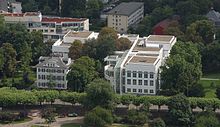
Richard Meier is an American abstract artist and architect, whose geometric designs make prominent use of the color white. A winner of the Pritzker Architecture Prize in 1984, Meier has designed several iconic buildings including the Barcelona Museum of Contemporary Art, the Getty Center in Los Angeles, the High Museum of Art in Atlanta, and San Jose City Hall. In 2018, some of Meier's employees accused him of sexual assault, which led to him resigning from his firm in 2021.

Henry Clemens van de Velde was a Belgian painter, architect, interior designer, and art theorist. Together with Victor Horta and Paul Hankar, he is considered one of the founders of Art Nouveau in Belgium. He worked in Paris with Siegfried Bing, the founder of the first gallery of Art Nouveau in Paris. Van de Velde spent the most important part of his career in Germany and became a major figure in the German Jugendstil. He had a decisive influence on German architecture and design at the beginning of the 20th century.

The applied arts are all the arts that apply design and decoration to everyday and essentially practical objects in order to make them aesthetically pleasing. The term is used in distinction to the fine arts, which are those that produce objects with no practical use, whose only purpose is to be beautiful or stimulate the intellect in some way. In practice, the two often overlap. Applied arts largely overlap with decorative arts, and the modern making of applied art is usually called design.

Günther Förg was a German painter, graphic designer, sculptor and photographer. His abstract style was influenced by American abstract painting.

Museumsufer is the name of a landscape of museums in Frankfurt, Hesse, Germany, lined up on both banks of the river Main or in close vicinity. The centre is the art museum Städel. The other museums were added, partly by transforming historic villas, partly by building new museums, in the 1980s by cultural politician Hilmar Hoffmann. The exhibition hall Portikus was opened on an island at the Alte Brücke in 2006.
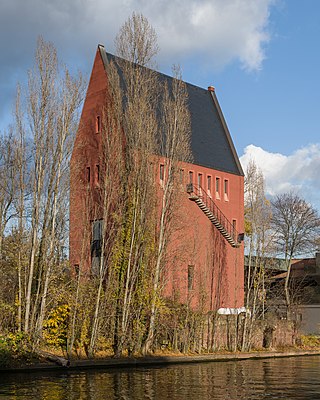
Portikus is an exhibition hall for contemporary art in Frankfurt am Main, that was founded in 1987 by Kasper König. The museum is part of Frankfurt's Museumsufer. Portikus presents the work of both internationally renowned artists and emerging artists. Almost always, artwork is commissioned for the gallery space.

Stefan Sagmeister is an Austrian graphic designer, storyteller, and typographer based in New York City. In 1993, Sagmeister founded his company, Sagmeister Inc., to create designs for the music industry. He has designed album covers for Lou Reed, OK Go, The Rolling Stones, David Byrne, Jay Z, Aerosmith, Talking Heads, Brian Eno and Pat Metheny. From 2011 until 2019 he partnered with Jessica Walsh under the name Sagmeister & Walsh Inc.
A design museum is a museum with a focus on product, industrial, graphic, fashion and architectural design. Many design museums were founded as museums for applied arts or decorative arts and started only in the late 20th century to collect design.

The Museum für Moderne Kunst, or short MMK, in Frankfurt, was founded in 1981 and opened to the public 6 June 1991. The museum was designed by the Viennese architect Hans Hollein. It is part of Frankfurt's Museumsufer . Because of its triangular shape, the MMK is popularly called the Tortenstück. Since 2018, Susanne Pfeffer has been director of the MMK.
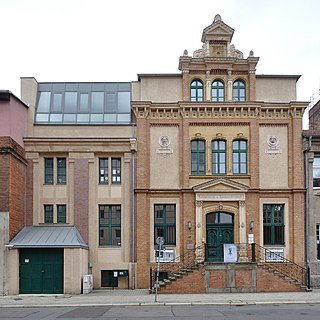
A Kunstgewerbeschule was a type of vocational arts school that existed in German-speaking countries from the mid-19th century. The term Werkkunstschule was also used for these schools. From the 1920s and after World War II, most of them either merged into universities or closed, although some continued until the 1970s.
Norbert Schoerner is a German photographer and filmmaker based in London.
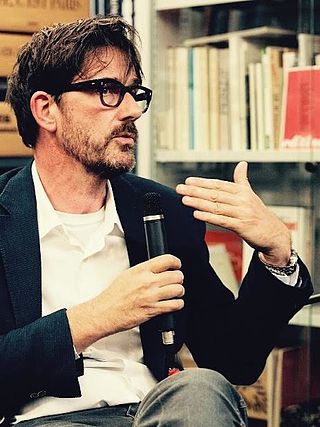
Peter Zizka is a German designer and conceptual artist.

The Museum Giersch is an art gallery on the Main River in Frankfurt am Main, Germany, in the Museumsufer area.

The Jewish Museum Frankfurt am Main is the oldest independent Jewish Museum in Germany. It was opened by Federal Chancellor Helmut Kohl on 9 November 1988, the 50th anniversary of Kristallnacht.
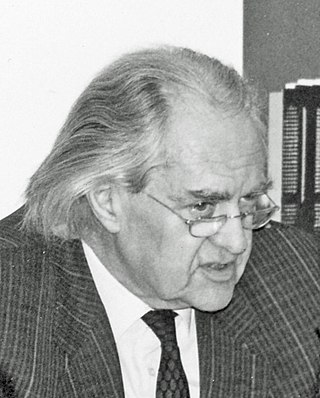
Hilmar Hoffmann was a German stage and film director, cultural politician and academic lecturer. He founded the International Short Film Festival Oberhausen. He was for decades an influential city councillor in Frankfurt, where he initiated the Museumsufer of 15 museums, including the Jewish Museum Frankfurt. He was the president of the Goethe-Institut and taught at universities such as Bochum and Tel Aviv. He wrote the book Kultur für alle, which was a motto of his life and work.

The Museum für Kunst und Gewerbe Hamburg is a museum of fine, applied and decorative arts in Hamburg, Germany. It is located centrally, near the Hauptbahnhof.

The Museum für Angewandte Kunst Köln is a decorative arts museum in Cologne. The collections include jewellery, porcelain, furniture, weaponry and architectural exhibits. Until 1987 it was called the Kunstgewerbemuseum.

The German Architecture Museum (DAM) is located on the Museumsufer in Frankfurt, Germany. Housed in an 18th-century building, the interior has been re-designed by Oswald Mathias Ungers in 1984 as a set of "elemental Platonic buildings within elemental Platonic buildings". It houses a permanent exhibition entitled "From Ancient Huts to Skyscrapers" which displays the history of architectural development in Germany.

Peter Welz is a contemporary German artist based in Berlin. He has been exhibiting his work in video, sculpture and installations since 2003.
